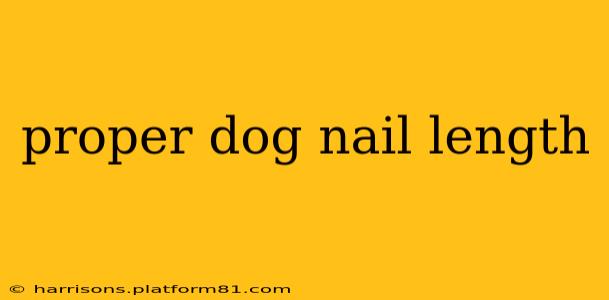Keeping your dog's nails at the proper length is crucial for their comfort and health. Overgrown nails can cause pain, discomfort, and even lead to serious orthopedic problems. This comprehensive guide will help you understand the ideal nail length, how to trim them safely, and answer some frequently asked questions.
What is the Proper Dog Nail Length?
The ideal nail length for your dog is when the nail just barely touches the ground when they stand. You should be able to hear a light click when they walk on a hard surface. If the nails are longer than this, they're likely too long and need trimming. Different breeds and even individual dogs may have slightly different ideal lengths, but the "barely touching the ground" rule is a good general guideline.
How to Tell if Your Dog's Nails are Too Long?
Several signs indicate your dog's nails are too long:
- Clicking sound: A loud clicking sound when your dog walks on hard surfaces is a clear indication.
- Curved or splayed paws: Overgrown nails can cause the paws to splay out.
- Lameness or limping: Long nails can put pressure on joints and cause pain, leading to limping.
- Difficulty walking: Your dog may struggle to walk comfortably or show signs of discomfort.
- Visible nail quick: The quick (the pink part containing blood vessels and nerves) becomes more prominent with longer nails. Trimming into the quick is painful and should be avoided.
How Often Should I Trim My Dog's Nails?
The frequency of nail trims depends on your dog's breed, activity level, and how quickly their nails grow. Some dogs may need their nails trimmed every 2-4 weeks, while others may only need it every few months. Regularly checking your dog's nails and trimming them as needed is the best approach. If you are unsure, consult your veterinarian.
What Happens if You Don't Trim Your Dog's Nails?
Neglecting to trim your dog's nails can lead to several problems:
- Pain and discomfort: Long nails cause pain when walking, standing, and sleeping.
- Joint problems: The added pressure and altered gait can lead to arthritis and other joint issues.
- Ingrown nails: Overgrown nails can curve and grow into the paw pads, causing infection and pain.
- Broken nails: Long nails are more prone to breaking, which can be painful and lead to bleeding.
What Tools Do I Need to Trim My Dog's Nails?
You'll need a suitable nail clipper for your dog's size and breed. Guillotine-style clippers and scissor-style clippers are common choices. Many pet stores sell styptic powder to stop any bleeding that may occur. Consider using a nail file to smooth out any rough edges after trimming.
How to Trim My Dog's Nails Safely?
Start by getting your dog used to having their paws handled. Reward them with treats and praise throughout the process. Hold their paw gently but firmly. Trim only the clear, hard part of the nail, avoiding the quick. If you accidentally cut into the quick, apply styptic powder to stop the bleeding. If you feel uncomfortable trimming your dog's nails, consult a professional groomer or veterinarian.
Can I Trim My Dog's Nails Myself?
Yes, many pet owners successfully trim their dog's nails at home. However, if you are unsure or uncomfortable, it's best to seek professional help from a groomer or veterinarian. They are experienced in handling dogs and have the tools and expertise to do it safely and efficiently.
My Dog Hates Getting Their Nails Trimmed, What Can I Do?
Introducing the process gradually and associating it with positive reinforcement (treats and praise) is key. Short, frequent sessions are better than one long stressful session. Consider using a high-value treat to keep your dog calm and focused. If your dog is excessively fearful or aggressive, consult a professional for guidance.
Are there Alternatives to Clipping?
Regular walks on hard surfaces can help to naturally wear down your dog's nails. However, this is rarely sufficient alone and should be combined with regular clipping to maintain proper length.
This guide provides a foundational understanding of proper dog nail length and maintenance. Remember, regular nail trims are a crucial aspect of your dog’s overall health and well-being. If you have any concerns, always consult with your veterinarian.
